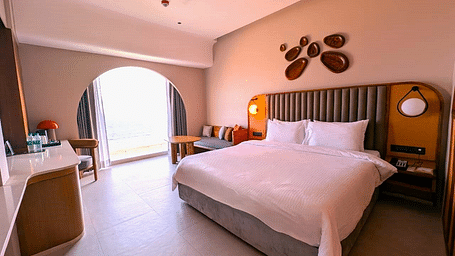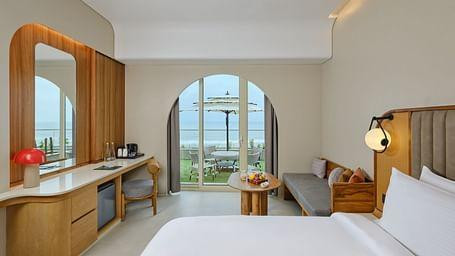121213
Author : Swostihotels | Published Date : 25-05-07
The air near the beach road in Puri doesn’t carry perfume — it carries motion. Vendors setting up with aluminum pots full of sabzi, the sound of sandals brushing against the wet sand, the distant thump of a temple bell — it all folds into a kind of quiet activity that starts before sunrise.
Along this coastal stretch, the sea isn’t hidden or framed — it’s just there. Visible from most hotel balconies, heard through half-closed windows, and always moving in the background, even when everything else pauses. Travelers arrive here from cities with louder mornings. And by the second day, they start walking slower.

Hotels facing the ocean in Puri don’t dress themselves up too much. Their signs fade under the salt air. Their gates open directly onto patches of sand. You might spot families gathered outside with thermos flasks and newspapers, or early risers doing nothing in particular — just watching waves make their slow return.
Mayfair Heritage, for instance, doesn’t startle with architecture. It’s broken up by gardens and narrow paths that make you take the longer route — in the best way. Walk across, and the beach is a short, uneven path down. You hear less traffic here. More crows. And that faint knock of a badminton game starting near the pool.
Further down, Hans Coco Palms is quieter still. Not silent, but soft. The building carries its years in the color of its walls and the way the floors creak just a bit when you walk across them. Guests don’t ask many questions here. They seem to arrive with books already half-read and shoes they don’t mind getting sandy.
Closer to Balighai, Hotel Chariot and Sterling Puri sit with more space around them. They catch stronger winds, less crowd and a private beach of their own. From their upper floors, the sea looks longer — a ribbon, not a backdrop. Some guests stay inside most of the day, stepping out only when the heat shifts or the tide draws back enough to walk.

This part of Puri feels less ceremonial than the temple lanes. It’s not quiet in the usual sense — not hushed — but it doesn’t compete for attention. The coast doesn’t sparkle here. It rolls, shifts, and occasionally pauses, as if even the sea needs a break from routine.
People don’t always talk about the hotels themselves. They talk about what they saw from their balconies. About the tea that arrived just hot enough. About the guard who told them when the tide would pull out. That’s the kind of detail that stays.
There’s something to be said about a place that lets you slow down without telling you to. Sea view hotels in Puri do that. Not by being luxurious or rare — but by being part of the setting. Familiar, weathered, and steady.
Sometimes, all a traveler really needs is a window, a little breeze, and a bit of space between things. In Puri, those are easier to find than most places.
Near Mayfair Heritage, there’s a short walk that leads toward the beachside stalls — places that serve tea in paper cups and fried snacks wrapped in newspaper. The hotel itself stays in the background while life happens outside. One morning, a family waited there with plates of puri sabzi while kids made vague shapes in the sand. It wasn’t dramatic — just ordinary and easy. That’s what the hotel allows. It doesn’t schedule your day. It just gives you a comfortable place to start it.
Hans Coco Palms has a lawn that doesn’t look landscaped — it just grows naturally, like someone trims it with care, not precision. There’s an old bench under a tree where guests often sit after breakfast. The chairs aren’t matching, and the silence isn't staged. Occasionally, a staff member will pass by with a slow nod or a towel for the pool, and that’s it. The sea’s edge is visible just beyond the fence — always close, always moving.
Sterling Puri’s staff keeps a low profile. You’ll find them quietly arranging towels by the pool or fixing the breakfast trays before guests notice. The hotel’s design gives you options: sunlit corridors, shaded balconies, or just a plain view of the sky and sea where nothing presses for your attention. It’s not unusual to see a solo traveler with a notepad or a child drawing shapes in the dust outside the lobby. Time moves differently here.
Empires and Holiday Resort sit closer to where the energy picks up — near Swargadwar. But even here, the hotels manage to create buffers. A garden wall, a shaded entryway, a slightly raised lobby. You hear the city, but it doesn't flood the room. Holiday Resort has a rooftop where guests often go not for the view, but for a little quiet. You can watch the locals playing beach cricket or the slow trail of a wedding procession along the road — everyday things that somehow feel worth watching.
Each hotel tells its own story, but they all share something unspoken. They let you be still. Not forced stillness, but the kind that happens when the surroundings give you no reason to rush. No one is trying to deliver an experience here. They’re just offering a place near the water where you can sit, eat, sleep, and maybe — if the day unfolds that way — do nothing at all.
In Puri, sea view hotels don’t compete with the sea. They lean back just enough to let it stay the main character.

